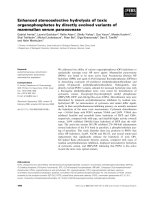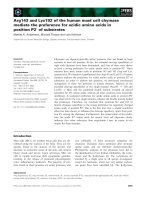Báo cáo khoa học: " A case report of pseudoprogression followed by complete remission after proton-beam irradiation for a low-grade glioma in a teenager: the value of dynamic contrast-enhanced MRI" pptx
Bạn đang xem bản rút gọn của tài liệu. Xem và tải ngay bản đầy đủ của tài liệu tại đây (741.81 KB, 5 trang )
CAS E REP O R T Open Access
A case report of pseudoprogression followed by
complete remission after proton-beam irradiation
for a low-grade glioma in a teenager: the value
of dynamic contrast-enhanced MRI
Candice Meyzer
1
, Frédéric Dhermain
2,3
, Denis Ducreux
3
, Jean-Louis Habrand
2,4
, Pascale Varlet
5
,
Christian Sainte-Rose
6
, Christelle Dufour
1
, Jacques Grill
1*
Abstract
A fourteen years-old boy was treated post-operatively with proton therapy for a recurrent low-grade oligodendro-
glioma located in the tectal region. Six months after the end of irradiation (RT), a new enhancing lesion appeared
within the radiation fields. To differentiate disease progression from radiation-induced changes, dynamic suscept-
ibility contrast-enhanced (DSCE) MRI was used with a T2* sequence to study perfusion and permeability charact er-
istics simultaneously. Typically, the lesion showed hypo perfusion and hyperpermeability compared to the
controlateral normal brain. Without additional treatment but a short course of steroids, the image disappeared over
a six months period allowing us to conclude for a pseudo-progression. The patient is alive in complete remission
more than 2 years post-RT.
Background
The occurrence of new contrast enhancing lesions on
routine MRI follow-up after radiation therapy (RT) for
brain gliomas was observed more than ten years ago but
remains problematic because standard MR imaging
techniques do not allow a clear distinction between
recurrent tumour and radiation-induced lesions [1,2].
Recently, “pseudo-progression” was defined as conven-
tional MR images compatible with progression, occur-
ring shortly after concomitant radio-chemotherapy
(CRC), as a transient phenomenon with spontaneous
improvement or stabilization after several months [3-5].
This was mainly described in adult and paediatric popu-
lations with high-grade g liomas whose new standard of
care is CRC followed by adjuvant chemotherapy [6,7].
We report here a clinical case showing a new con-
trast-enhancing lesion discovered on a systematic MRI
proposed to a fourteen years-old boy treated six months
before for a recurrent low-grade glioma by surgery and
proton-therapy. Dynamic Susceptibility Contrast (DSC)
MR imaging and planned follow-up lead to the diagnosis
of pseudo-progression. This phenomenon has rarely
been described in children with supra-tentorial low-
grade gliomas after proton b eam RT, particularly with
this type of advanced MR technique.
Case Presentation
Initial presentation and conventional MRI description
A healthy ten year-old boy with tinnitus and bilateral
papillary oedema underwent a brain MRI showing a
small tumour of the tectal plate. The lesion presented a
signal of low intensity on T1-weighted and a high signal
on T2-weighted sequences. No contrast enhancement
was visible. The process was responsible for triventricu-
lar hydrocephalus by aqueduct compression. The first
treatment was a ventriculocysternostomy followed, fif-
teen months later, by a partial resection when the lesion
increased in size. Histopathological diagnosis was a
grade II oligodendroglioma (WHO cl assificat ion), with a
proliferation index (MIB 1) of 5%. Three years after the
first surgery, a systematic follow-up MRI revealed a
recurrence localized on the quadrigeminal plate, close to
the left thalami and the third ventricle, again without
* Correspondence:
1
Department of Pediatric and Adolescent Oncology, Gustave Roussy
Institute, 39 Rue Camille Desmoulins, 94805 Villejuif, France
Meyzer et al. Radiation Oncology 2010, 5:9
/>© 2010 Meyzer et al; licensee BioMed Central Ltd. This is an Open Access article distributed under the terms of the Creative Commons
Attribution License (http://creati vecommons.org/licenses/by/2.0), which permits unrestricted use, distribution, and reproduction in
any medium, provided the original work is properly cited.
gadolinium enhancement. A second surgery was
attempted, showing the same histology, but a tumour
residue was left on the left thalamus (Figure 1). Treat-
ment was completed six weeks later by RT using proton
beams, delivering 54 Gy in 30 fractions of 1.8 Gy. Radia-
tion fields encompassed the medial parts of the thalami
(Figure 1C, D). Radiological and clinical data were then
evaluated every 3 months thereafter. Six months after
RT, systematic MRI found obvious development of a
new lesion with an important contrast enhancement and
mass effect on the third ventricle (Figure 2), however
the patient remained asymptomatic.
Conventional and Dynamic MRI with Permeability
visualization and Perfusion estimate
In order to more accurately differentiate tumour recur-
rence from radiation-induced changes, a DSC-MRI was
performed as described previously [8,9]. The T2*
sequence was used in order to assess simultaneously
perfusion and permeability characteristics, as recently
proposed for predicting risk of recurrence in adult low-
grad e gliomas [10]. In this case, the typical combination
of a focused area of high permeability strictly superim-
posed on the contrast enhancing lesion combined with
the absence of high perfusion estimate in the same
region (Figure 3) was compatible with post-radiation
modifications, as recently suggested by Hu et al. They
found a direct correlation between image-guided tissue
histopathology and localized DSC perfusion MR imaging
measurements in a series of adult high-grade gliomas
[11]. Consequently, we favoured the hypothesis of a
delayed radiation injury and began a treatment with oral
steroids (prednisone) at one mg/kg/d for one month
before clinical and radiological reappraisal. After one
month, decrease in size of contrast enhancement
bec ame significant while the patient remained asympto-
matic. Steroids were therefore discontinued. Gradual
improvement continued on conventional MRI and dis-
appearance of both contrast enhancement and high per-
meability area strongly suggested a pseudo-progression
rather than recurrent disease. Follow-up MRI at nine
months post-RT showed a complete resolution of the
gadolinium uptake and no detectable microvascular
leakage (Figure 4). At last follow-up, patient is still in
complete remission, more than two years post-RT.
Post-treatment modifications, evolution with time and
micro-vascular hypothesis
Subacute radiation-induced modifications have been
described previously in childhood gliomas, with or
A
C
B
D
Figure 1 Conventional MR imaging, Target volume and Dosimetry of a Low-grade Glioma. A left thalamic low-grade oligodend roglioma
in a 10 year-old boy after partial resection, without contrast enhancement. [A] T1-weighted transaxial MR image after administration of
intravenous Gd-DTPA [B] T2 -weighted sequence which shows ill-defined nodular images. [C] Representation of Gross tumor volume (in red) and
Clinical target volume (in green). [D] Radiation field encompassing medial part of the left thalamus.
Meyzer et al. Radiation Oncology 2010, 5:9
/>Page 2 of 5
without concomitant or sequential use of chemotherapy
[1,12-14]. In adults, these changes are more and more
reported after combined radio-chemotherapy [4,5,15].
MRI findings usuall y consist on new contrast enhancing
mass on T1-weighted imaging with gadolinium, which is
indistinguishable from tumour progression. It occurs
usually within the irradiated tumour volume but radia-
tion-induced lesions could be located less commonly in
the controlateral hemisphere, remotely from the primary
tumour site [6]. To our knowledge, it is the first case of
pseudo-progression fully described after exclusive pro-
ton RT. Here, time of occurrence was delayed (6
months) since the typical time frame is rather w ithin 3
months after chemo-radiation, possibly due to the
absence of concomitant chemotherapy [3,5,6]. Cerebral
injury has been classified according to ti me to appear-
ance after RT [8] as “acute”, with brain oedema occur-
ring during RT, mostl y tra nsient and reversible;
subacute or “ early delayed” injury, occurring a few
weeks to three months post-RT, improving within six
weeks; late injury, occurring months to y ears post-RT,
including true radionecrosis. It is often irrever sible, pro-
gressive, and possibly lethal and constitutes the major
dose-limiting clinical complication of brain irradiation,
particularly in children. Pseudo-progression (PsP) could
be considered as a pathological continuum between
acute post-RT reaction and treatment-related necrosis
[6]. Mechanisms behind these events are no t fully
understood but are probably related to micro-vessels
changes. Post-RT brain injury induces a focal tissue
reaction with inflammatory component and increased
capillary permeability, causing fluid transudation into
the i nterstitial space and brain oedema. Transient
alterations in the blood-brain barrier may be responsible
for new or increased contrast enhancement, falsely sug-
gesting tumour progression, with low perfusion values
[11].
Role of PET and advanced MR techniques in the diagnosis
of “pseudo-progresion”, clinical implication
This DSC-MR technique evaluates tissue changes, close
to the physiopathology of PsP, whereas metabolic tools
as FDG-PET or MR spectroscopy (MRS) analyse level of
Figure 2 Conventional MR imaging before and six months after
exclusive Proton therapy. [A] T1-weighted transaxial MR image
after administration of intravenous (iv) Gd-DTPA, one week before
radiation. [B] The same sequence, six months after the end of
irradiation (54 Gy), showing a strong contrast enhancement with a
subtle mass effect (yellow arrow).
Figure 3 Six months after irradiation: superimposed MR
images with T1-weighted sequence after iv Gadolinium
injection and co-registered Perfusion (left) and Permability
maps (right). [A] Gradient-echo axial image with color overlay map
showing no focus of hyperperfusion in regard of the strong contrast
enhancement [B] The superimposed Permeability map with a strong
microvascular leakage (yellow arrow) strictly corresponding with the
enhanced area in the T1-weighted sequence.
Figure 4 Nine months after irradiation: complete disappearance
of the contrast enhancement (left) and no detectable
Permeability (right). [A] T1-weighted transaxial MR image after
administration of iv Gd-DTPA and [B] the superimposed Permeability
map, with no contrast enhancement or detectable microvascular
leakage. To be noted, a subtle hypersignal, pre-existing to the
irradiation, as a post-operative modification (yellow arrow).
Meyzer et al. Radiation Oncology 2010, 5:9
/>Page 3 of 5
glucose uptake or distribution of metabolites peaks.
MRS can distinguish recurrent true necrosis from active
tumour [16-18] but it needs long acquisition time. In
18
FDG-PET, FDG uptake is not specific of tumour tissue
and false positive can be observed in non malignant
inflammatory processes. The use of aminoacid tracers as
11
C-methionine better discriminates post-RT necrosis
from tumour recurrence [19] but it is rarely available in
daily practice. Recently, the DSC-MR technique was
proposed for adult high-grade gliomas in this situation
[20,21] as a n alternative tool. It can be incorporated in
the routine follow-up, within the interval of three to six
months post-RT where PsP can be observed. Impor-
tantly, there is a risk of including children with gliomas
in phase II studies for “recurrent disease” that would be
spontaneously reversible, leading to false positive results,
consequently delivering salvage treatments for “pseudo-
progressive” patients who could be, at the contrary,
potentially long term survivors [15].
Conclusion
The lack of typical clinical symptoms and the limits of
anatomical MRI techniques imply that any subacute
change suggesting disease progression may be consid-
ered as possible PsP. Post-RT therapy should not be
interrupted too early [22] and DSC-MRI could help for
distinguishing PsP from real progression.
Consent
Written informed consent was obtained from the par-
ents and the patient for publication of this case report
and accompagnying images. A copy of the written con-
sent is available for review by the Editor-in-Chief of this
journal.
Author details
1
Department of Pediatric and Adolescent Oncology, Gustave Roussy
Institute, 39 Rue Camille Desmoulins, 94805 Villejuif, France.
2
Department of
Radiation Therapy, Gustave Roussy Institute, Villejuif, France.
3
LIMEC, INSERM
UMR 788, University Hospital, Kremlin-Bicêtre, France.
4
Centre de
Protonthérapie, Orsay, France.
5
Department of Neuropathology, Sainte-Anne
Hospital, Paris, France.
6
Depatment of Neurosurgery, Necker Sick Children’s
Hospital, Paris, France.
Authors’ contributions
CM collected the data and wrote the manuscript. FD analysed the imaging
studies and contributed to the legend of figures and correction of the
manuscript. DD created and developed the software used to treat T2*
acquisition and produce the images. JLH supervised the irradiation of the
patient. PV analysed the histology of the tumour. CSR operated the patient.
CD was the treating physician of the patient. JG supervised the manuscript.
All authors read and approved the final manuscript.
Competing interests
The authors declare that they have no competing interests.
Received: 15 October 2009
Accepted: 4 February 2010 Published: 4 February 2010
References
1. Bakardjiev AI, Barnes PD, Goumnerova LC, Black PM, Scott RM, Pomeroy SL,
Billet A, Loeffler JS, Tarbell NJ: Magnetic resonance imaging changes after
stereotactic radiation therapy for childhood low grade astrocytoma.
Cancer 1996, 78:864-873.
2. Sugahara T, Korogi Y, Tomiguchi S, Shigematsu Y, Ikushima I, Kira T, Liang L,
Ushio Y, Takahashi M: Posttherapeutic intra-axial brain tumor: the value
of perfusion-sensitive contrast-enhanced MR imaging for differentiating
tumor recurrence from non-neoplastic contrast enhancing tissue. AJNR
Am J Neuroradiol 2000, 21:901-909.
3. De Wit, de Bruin HG, Eljkenboom W, Sillevis Smitt PA, Bent van den MJ:
Immediate post-radiotherapy changes in malignant glioma can mimic
tumor progression. Neurology 2004, 63:535-537.
4. Chamberlain MC, Glantz MJ, Chalmers L, Van Horn A, Sloan AE: Early
necrosis following concurrent Temodar and radiotherapy in patients
with glioblastoma. J Neurooncol 2007, 82:81-83.
5. Taal W, Brandsma D, de Bruin HG, Bromberg JE, Swaak-Kragten AT,
Smitt PA, van Es CA, Bent van den MJ: Incidence of early pseudo-
progression in a cohort of malignant glioma patients treated with
chemoirradiation with temozolomide. Cancer 2008, 113(2):405-410.
6. Brandsma D, Stalpers L, Taal W, Sminia P, Bent van den M: Clinical features,
mechanisms, and management of pseudoprogression in malignant
gliomas. Lancet Oncol 2008, 9:453-461.
7. Lafay-cousin L, Feniak J, Wilson B, Wei X, Rotaru C, Bouffet E, Strother D:
Pseudoprogression in pediatric diffuse pontine glioma treated with
radiation and concomitant temozolomide [Abstract]. Neuroncology 2008,
10:393.
8. Cao Y, Shen Z, Chenevert TL, Ewing JR: Estimate of vascular permeability
and cerebral blood volume using Gd-DPTA Contrast enhancement and
dynamic T2*-weighted MRI. J Magn Reson Imaging 2006, 24:288-296.
9. Boxerman JL, Schmainda KM, Weisskoff RM: Relative cerebral blood
volume maps corrected for contrast agent extravasation significantly
correlate with glioma tumor grade, whereas uncorrected maps do not.
AJNR Am J Neuroradiol 2006, 27:859-867.
10. Dhermain F, Saliou G, Parker F, Page P, Hoang-Xuan K, Lacroix C, Tournay E,
Bourhis J, Ducreux D: Microvascular leakage and contrast enhancement
as prognostic factors for recurrence in unfavorable low-grade gliomas. J
Neurooncol 2009.
11. Hu LS, Baxter LC, Smith KA, Feuerstein BG, Karis JP, Eschbacher JM,
Coons SW, Nakaji P, Yeh RF, Debbins J, Heiserman JE: Relative cerebral
blood values to differentiate high-grade glioma recurrence from post-
treatment radiation effect: direct correlation between image-guided
tissue histopathology and localized dynamic susceptibility-weighted
contrast-enhanced perfusion MR imaging measurements. AJNR Am J
Neuroradiol 2009, 30:552-558.
12. Ridola V, Grill J, Doz F, Gentet JC, Frappaz D, Raquin MA, Habrand JL,
Sainte-Rose C, Valteau-Couanet D, Kalifa C: High-dose chemotherapy with
autologous stem cell rescue followed by posterior fossa irradiation for
focal medulloblastoma recurrence or progression after conventional
chemotherapy. Cancer 2007, 110:156-63.
13. Spreafico F, Gandola L, Marchiano A, Simonetti F, Poggi G, Adduci A,
Clerici CA, Luksch R, Biassoni V, Meazza C, Catania S, Terenziani M,
Musumeci R, Fossati-Bellani F, Massimino M: Brain magnetic resonance
imaging after high-dose chemotherapy and radiotherapy for childhood
brain tumors. Int J Radiat Oncol Biol Phys 2008, 70:1011-9.
14. Fouladi M, Chintagumpala M, Laningham FH, Ashley D, Kellie SJ,
Langston JW, McCluggage CW, Woo S, Kocak M, Krull K, Kun LE,
Mulhern RK, Gajjar A:
White matter lesions detected by magnetic
resonance imaging after radiotherapy and high-dose chemotherapy in
children with medulloblastoma or primitive neurectodermal tumor. J
Clin Oncol 2004, 22:4551-60.
15. Brandes AA, Tosconi A, Spagnolli F, Frezza G, Leonardi M, Calbucci F,
Franceschi E: Disease progression or pseudoprogression after
concomitant radiochemotherapy treatment: pitfalls in neurooncology.
Neuro Oncology 2008, 10:361-367.
16. Schlemmer HP, Bachert P, Herfarth KK, Zuna I, Debus J, van Kaick G: Proton
MR spectroscopic evaluation of suspicious brain lesions after stereotactic
radiotherapy. AJNR Am J Neuroradiol 2001, 22:1316-1324.
17. Zeng QS, Li CF, Liu H, Zhen JH, Feng DC: Distinction between recurrent
glioma and radiation injury using magnetic resonance spectroscopy in
Meyzer et al. Radiation Oncology 2010, 5:9
/>Page 4 of 5
combination with diffusion-weighted imaging. Int J Radiat Oncol Biol Phys
2007, 68:151-158.
18. Rock JP, Scarpace L, Hearshen D, Gutierrez J, Fisher JL, Rosenblum M,
Mikkelsen T: Associations among Magnetic Resonance Spectroscopy,
Apparent Diffusion Coefficients, and Image-Guided Histopathology with
Special Attention to Radiation Necrosis. Neurosurgery 2004, 54:1111-1119.
19. Terakawa Y, Tsuyuguchi N, Iwai Y, Yamanaka K, Higashiyama S, Takami T,
Ohata K: Diagnostic accuracy of 11C-methionine PET for differentiation
of recurrent brain tumors from radiation necrosis after radiotherapy. J
Nucl Med 2008, 49:694-99.
20. Barajas RF Jr, Chang JS, Segal MR, Parsa AT, McDermott MW, Berger MS,
Cha S: Differentiation of recurrent glioblastoma multiforme from
radiation necrosis after external beam radiation therapy with dynamic
susceptibility-weighted contrast-enhanced perfusion MR imaging.
Radiology 2009, 253:486-496.
21. Dandois V, Rommel D, Renard L, Jamart J, Cosnard G: Substitution of
11
C-
methionine PET by perfusion MRI during the follow-up of treated high-
grade gliomas: preliminary results in clinical practice. J Neuroradiol 2009.
22. Mason WP, Del Maestro M, Eisenstat D, Forsyth P, Fulton D, Laperrière N,
Macdonald D, Perry J, Thiessen B, for the Canadian GBM Recommandations
Committee: Canadian recommendations for treatment of glioblastoma
multiforme. Current Oncol 2007, 14:110-117.
doi:10.1186/1748-717X-5-9
Cite this article as: Meyzer et al.: A case report of pseudoprogression
followed by complete remission after proton-beam irradiation for a
low-grade glioma in a teenager: the value of dynamic contrast-
enhanced MRI. Radiation Oncology 2010 5:9.
Submit your next manuscript to BioMed Central
and take full advantage of:
• Convenient online submission
• Thorough peer review
• No space constraints or color figure charges
• Immediate publication on acceptance
• Inclusion in PubMed, CAS, Scopus and Google Scholar
• Research which is freely available for redistribution
Submit your manuscript at
www.biomedcentral.com/submit
Meyzer et al. Radiation Oncology 2010, 5:9
/>Page 5 of 5
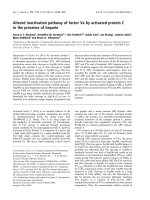
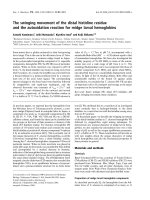
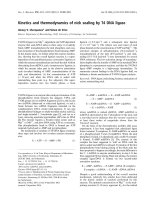
![Báo cáo khoa học: Uptake and metabolism of [3H]anandamide by rabbit platelets Lack of transporter? ppt](https://media.store123doc.com/images/document/14/rc/cg/medium_cgh1394241609.jpg)

